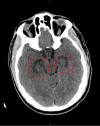Opioid-Associated Amnestic Syndrome
- PMID: 34877229
- PMCID: PMC8642152
- DOI: 10.7759/cureus.20056
Opioid-Associated Amnestic Syndrome
Abstract
Opioid-associated amnestic syndrome (OAS) is a relatively new condition that is associated with opioid abuse and has increased in prevalence since the notable rise in opioid-related deaths and opioid-related hospitalizations of the opioid crisis. Patients often present with acute anterograde amnesia and current opioid abuse, most commonly fentanyl. OAS is frequently diagnosed when other potentially infectious or metabolic conditions such as encephalitis and seizures are ruled out, as these conditions can also present similarly to OAS. This case highlights the signs, symptoms, and hallmark characteristics of OAS, including bilateral hippocampal edema and anterograde amnesia.
Keywords: amnesia; hippocampal edema; opioid crisis; opioid-associated amnestic syndrome; substance abuse.
Copyright © 2021, Walker et al.
Conflict of interest statement
The authors have declared that no competing interests exist.
Figures


References
-
- Opioid-associated amnestic syndrome: description of the syndrome and validation of a proposed definition. Barash JA, Whitledge J, Watson CJ, et al. J Neurol Sci. 2020;417:117048. - PubMed
-
- Acute amnestic syndrome associated with fentanyl overdose. Barash JA, Ganetsky M, Boyle KL, et al. N Engl J Med. 2018;378:1157–1158. - PubMed
Publication types
LinkOut - more resources
Full Text Sources
